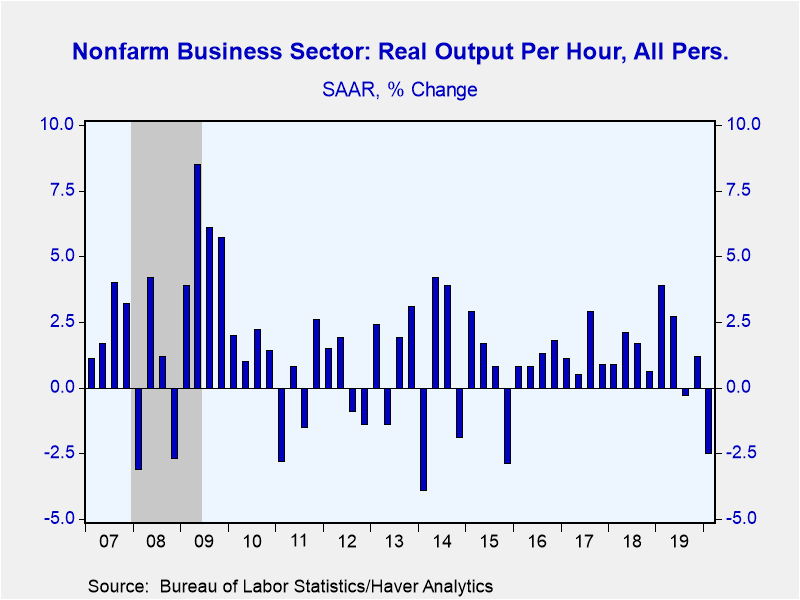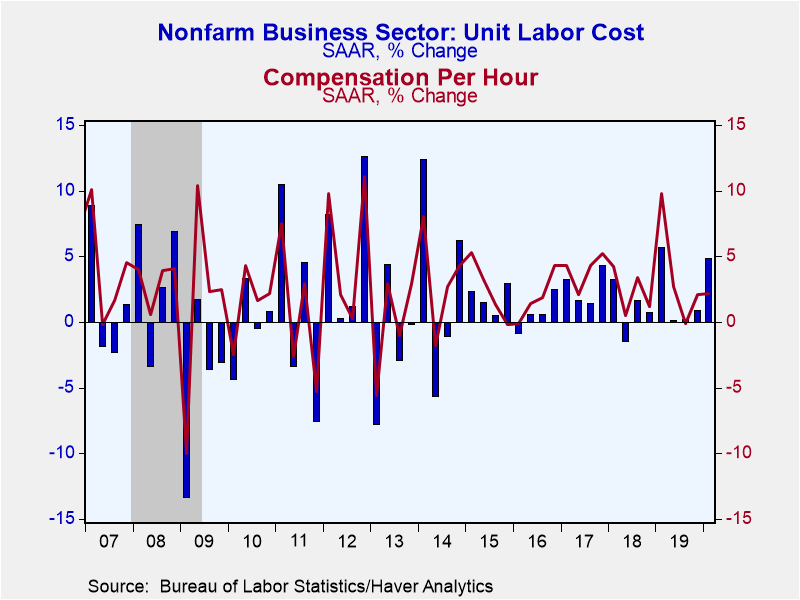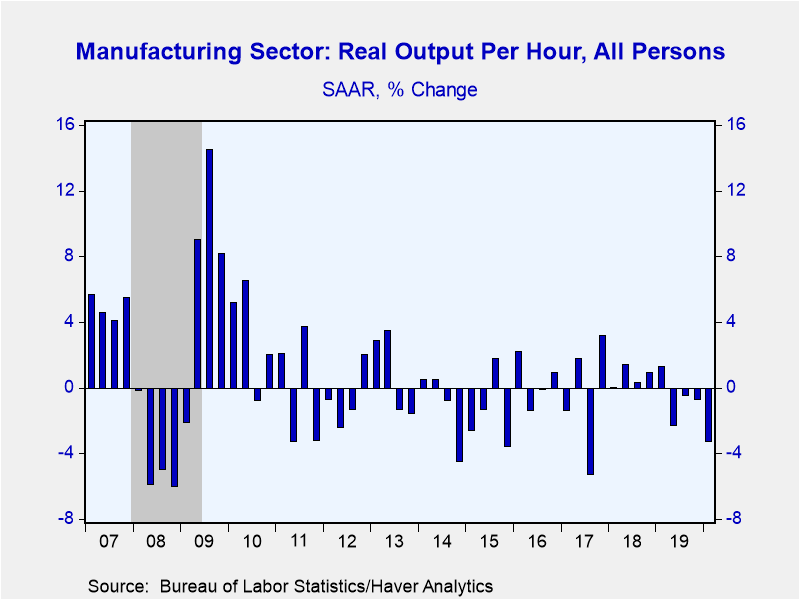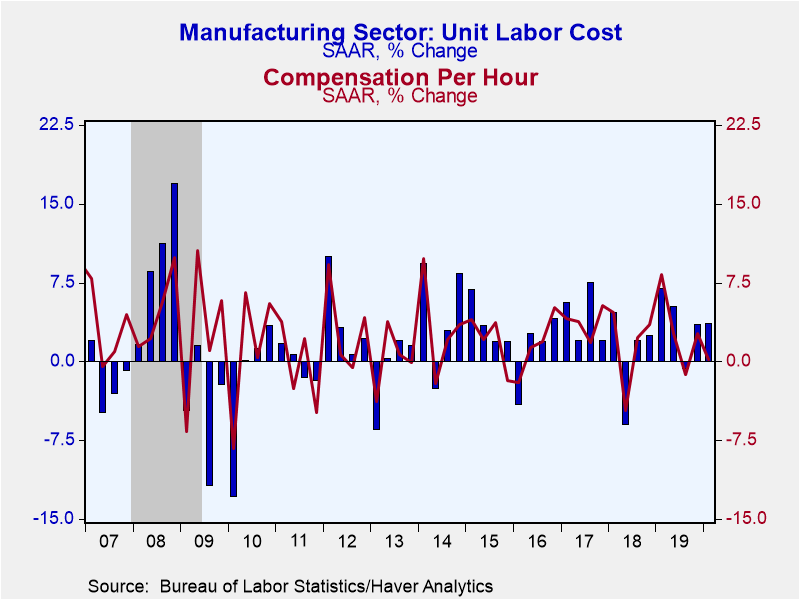 Global| May 07 2020
Global| May 07 2020U.S. Productivity Declines; Unit Labor Costs Surge in Q1'20
by:Tom Moeller
|in:Economy in Brief
Summary
• Output per hour fell as recessionary forces emerge. • Unit labor costs rise and set one-year high. Productivity in the nonfarm business sector during Q1'20 fell 2.5% (SAAR) after an unchanged 1.2% Q4'19 rise. A 5.2% decline had been [...]
U.S. Productivity Declines; Unit Labor Costs Surge in Q1'20
by Tom Moeller May 7, 2020
• Output per hour fell as recessionary forces emerge.
• Unit labor costs rise and set one-year high.
Productivity in the nonfarm business sector during Q1'20 fell 2.5% (SAAR) after an unchanged 1.2% Q4'19 rise. A 5.2% decline had been expected in the Action Economics Forecast Survey. The decline lowered the y/y rise in productivity to 0.3%, its weakest gain since a slight decline in Q3'16. Output was off 6.2% (+0.1% y/y) while hours-worked fell 3.8% (-0.2% y/y).
Compensation increased 2.2% (1.7% y/y). The gain followed a similar rise during Q3. Adjusted for price changes, compensation rose 0.9% (-0.4% y/y). Unit labor costs jumped 4.8% during Q1, the largest increase in four quarters. The gain left the y/y increase steady at 1.5%. A 2.1% rise had been expected.
In the manufacturing sector, productivity declined at a 3.3% annual rate (-1.7% y/y), the largest of four consecutive quarterly shortfalls. Output weakened 7.1% (-2.4% y/y) while hours worked fell 3.9% (-0.7% y/y.
Compensation in the factory sector edged 0.2% higher (1.1% y/y). Adjusted for price inflation, compensation fell 1.0% both q/q and y/y. The compensation rise, combined with the shortfall in productivity, lifted unit labor costs in the factory sector by a 3.6% annual rate (2.9% y/y).
The productivity & cost figures are available in Haver's USECON database.
U.S. Consumer Credit Usage Ramps Up in February, Pre-Coronavirus
by Tom Moeller May 7, 2020
Consumer credit outstanding increased $22.3 billion (4.5% y/y) during February following an unrevised $12.0 billion January gain. It was the strongest monthly increase since July. A $14.0 billion gain had been expected by the Action Economics Forecast Survey.
Nonrevolving credit usage surged $18.1 billion (4.9% y/y) during February, the strongest monthly increase since September 2015. Borrowing from the federal government, which issues over 40% of nonrevolving credit, grew 6.8% y/y. Depository institution loans (25% of credit) gained 5.0% y/y. Finance company borrowing (13.0% of loans) grew 1.1% y/y and credit union borrowing (7.0% of loans) rose 2.9% y/y.
Revolving consumer credit balances rose $4.2 billion (3.2% y/y) in February after falling $2.5 billion in January. Credit provided by depository institutions, which makes up 90% of revolving balances, grew 3.4% y/y. Credit union borrowing rose 6.1% y/y and finance company loans fell 3.3% y/y.
Student loans grew a reduced 4.7% y/y while motor vehicle loans rose a steady 3.8% y/y.
These Federal Reserve Board figures are break-adjusted and calculated by Haver Analytics. The breaks in the series in 2005, 2010 and 2015 are the result of the incorporation of the Census and Survey of Finance Companies, as well as changes in the seasonal adjustment methodology.
The consumer credit data are available in Haver's USECON database. The Action Economics figures are contained in the AS1REPNA database.
| Consumer Credit Outstanding (M/M Chg, SA) | Mar | Feb | Jan | Mar % y/y | 2019 | 2018 | 2017 |
|---|---|---|---|---|---|---|---|
| Total ($ bil) | 22.3 | 12.0 | 4.5 | 4.5 | 4.8 | 5.0 | |
| Nonrevolving | 18.1 | 14.5 | 4.9 | 4.8 | 5.4 | 4.9 | |
| Revolving | 4.2 | -2.5 | 3.2 | 3.8 | 3.1 | 5.6 |
Tom Moeller
AuthorMore in Author Profile »Prior to joining Haver Analytics in 2000, Mr. Moeller worked as the Economist at Chancellor Capital Management from 1985 to 1999. There, he developed comprehensive economic forecasts and interpreted economic data for equity and fixed income portfolio managers. Also at Chancellor, Mr. Moeller worked as an equity analyst and was responsible for researching and rating companies in the economically sensitive automobile and housing industries for investment in Chancellor’s equity portfolio. Prior to joining Chancellor, Mr. Moeller was an Economist at Citibank from 1979 to 1984. He also analyzed pricing behavior in the metals industry for the Council on Wage and Price Stability in Washington, D.C. In 1999, Mr. Moeller received the award for most accurate forecast from the Forecasters' Club of New York. From 1990 to 1992 he was President of the New York Association for Business Economists. Mr. Moeller earned an M.B.A. in Finance from Fordham University, where he graduated in 1987. He holds a Bachelor of Arts in Economics from George Washington University.










